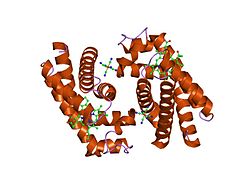Structural Biochemistry/Protein function/Additional Globins2
Neuroglobin and Cytoglobin are two new heme-containing repiratory proteins, which were revealed through the human genome sequence. These proteins are both monomeric, and are structurally similar to myoglobin more than hemoglobin. The expression of neuroglobin is restricted to the brain and is mostly observed in the retina. Its roles include protecting neural tissue from hypoxia and insufficient oxygenation of the blood, through its roles in neuronal oxygen homeostasis. Cytoglobin on the other hand is expressed mainly in fibroblasts and other similar cells throughout the body, and may be involved in collagen synthesis. Spectroscopy data has shown that both proteins have the proximal and sital histidines coordinated to iron in the deoxy form and the distal histidine is displaced on oxygen binding.

History of Neuroglobin
[edit | edit source]Neuroglobin was first identified by an Italian researcher, Thorsten Burmester et al. in 2000, and the 3D structure of the neuroglobin of human body was discovered in 2003. In 2004, the neuroglobin of murine was determined at a further highly resolution.
Functions of Neuroglobin
[edit | edit source]Neuroglobin, has the symbol of NGB, is an intracellular hemoprotein that involved in cellular oxygen homeostasis. Neuroglobin is a monomer which expressed in the central nervous system, retina, endocrine tissues, and cerebrospinal fluid. Neuroglobin reversibly binds oxygen with affinity which is higher than hemoglobin, and also increase the existence of oxygen in brain tissue and gives the protection under ischemic or hypoxic conditions in order to limiting the brain damages.

Functions of Cytoglobin
[edit | edit source]Cytoglobin is the protein product that can be found in human body and mammalian. Just like the Neuroglobin, Cytoglobin is also a globin molecule located in the brain of mostly marine mammals. It has always been considered to be a method to protect the brain under the condition called hypoxia.Cytoglobin is also the transferring reagent of oxygen from arterial blood to the brain. Cytoglobin is a hexacoordinate hemoglobin. It may scavenge reactive oxygen species such as nitric oxide, and also facilitate diffusion of oxygen through tissues, or serve a protective function during oxidative stress
References
[edit | edit source]Berg, Jeremy "Biochemistry", Chapter 7 Hemoglobin: Portrait of a Protein in Action. 197-198. sixth edition. Freeman and Company, 2007.
